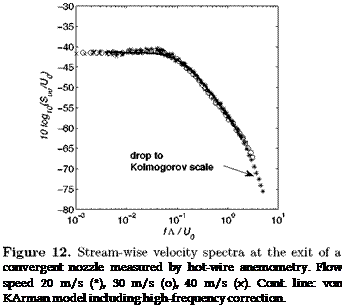Application to Airfoil Broadband Noise Modeling
The equivalent source distributions derived analytically in previous sections are now used for a statistical description of the far-field noise. For tonal noise predictions, they would be applied directly. It must be noted that the theoretical background of Amiet’s theory and equivalent formulations ignore the aerodynamic wavenumber of the incident disturbances in the direction normal to the airfoil plane, say k3. This together with the flat-plate assumption is considered enough for most broadband noise modeling purposes. More sophisticated and fully three-dimensional approaches
are possible, but they are beyond the scope of the course and most often not tractable anymore by analytical methods.
5.1 Statistical Turbulence-Interaction Noise Model
Once the radiation integral corresponding to a single gust is obtained from the distributed unsteady lift analytically, the power spectral density (PSD) of the far-field sound pressure Spp is related to the statistics of the upstream turbulent velocity field via spectral turbulent models used as input data. The complete formulation for a rectangular airfoil reads
 |
where §ww is the two-dimensional wave-number spectrum of the turbulent velocity component normal to the airfoil. The full expression is required for short-span airfoils, most often encountered in rotating blade applications. For large-span airfoils, typically high-lift flaps such that the aspect ratio L/е ^ ж, an approximate expression follows from the equivalence of the sine-cardinal function with Dirac’s delta function, as
![]()
It is worth noting that the wall pressure field does not enter the formulation directly though it is the equivalent source of the sound according to the acoustic analogy. In fact resorting to unsteady aerodynamic theories displaces the needed input data from lift fluctuations to incident velocity fluctuations. In this interpretation the airfoil acts as a converter of velocity disturbances into acoustic pressure waves.
The statistics of the upwash component is not of easy access in experiments because it requires using for instance cross-wire two-dimensional anemometry. Single hot-wire anemometry is more tractable but it provides only the power spectral density of the stream-wise velocity component Suu. The information on Sww can be reconstructed from Suu by fitting the parameters (urms, Л) of one of the aforementioned turbulence models on the measurements, with wrms = urms. This is done typically in the experiments mentioned in the next section, in which airfoils are tested in grid-generated turbulence. Model expressions for Suu according to von K+rman and Liep – mann are respectively given as (Hinze (1975))
 |
A typical check against hot-wire measured spectra is reported in Fig. 12. The measurements are made in the presence of a turbulence grid placed upstream of the nozzle contraction in an open-jet wind tunnel, at different speeds. The distance to the grid is too short for obtaining ideal homogeneous and isotropic turbulence but ensures a higher fluctuating level. The agreement is not perfect but well satisfactory enough for acoustic applications. By the way the collapse in non-dimensional variables confirms that grid-generated turbulence is a self-similar flow. For a better consistency a correction can been applied to force the model spectral envelope to decrease at the highest frequencies towards the Kolmogorov scale, if these frequencies effectively contribute to the sound.
If turbulence parameters must be estimated from RANS simulations, they are related to the turbulent kinetic energy K and the dissipation є as
Reliability issues remain when non-homogeneous turbulence is addressed or when the local turbulence parameters vary over distances which are not
large when compared to the airfoil chord. For instance, the predictions of turbulence-impingement noise of a ring-airfoil placed in the mixing layer of a round jet reported by Roger (2010) are based on measured Suu turbulent spectra. For a ring of same diameter as the jet, the predictions compare very well with the measurements, because turbulence in the middle of the jet shear layers is quite close to homogeneity. In contrast the disagreement observed with smaller or larger rings is attributed to significant departure from homogeneous and isotropic turbulence away from the center shear layer. In another context, the complex flows developing over high-lift devices of aircraft wings such as deployed flaps also exhibit strong variations in the vicinity of the flap leading edge; applying the methodology in such a case becomes questionable.











